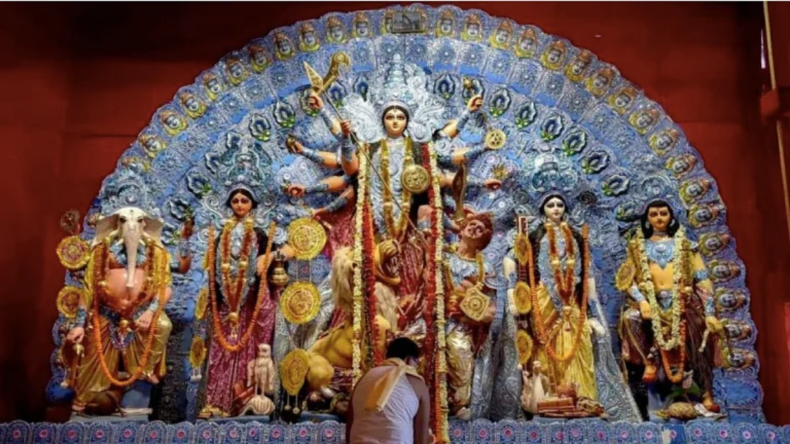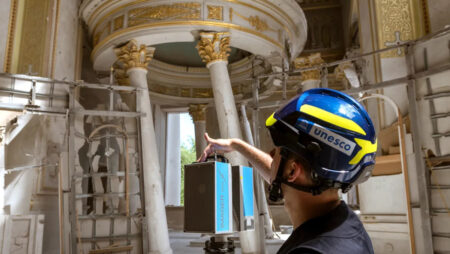Durga Puja, also known as Shakti worship, has carved itself a distinct niche in this religious landscape during the previous three centuries. The goddess is seldom worshipped as a home deity, and there is no temple devoted to her, although she is widely adored and honoured among groups.
During the week-long celebration, millions of people traverse miles on foot, bouncing from one pandal (temporary decorative installation) to another, from dusk until late at night. It is become a global spectacle, inextricably tied to the cultural identity of Bengali Hindus.
During Durga Puja, the city never sleeps, and many Muslims and Christians participate in the celebrations. According to the number of temples and their popularity as household deities, Bengal has long been a land of Kali, Shiva, and Radha-Krishna.
Buddhism, Tantrik Buddhism, and folk deities ruled this country before the arrival of Vedic civilization in the fifth century. Bengal has also adopted Shaivism and Gaudiya Vaishnavism. It has remained primarily a Kalikula Shakti and folk deity territory despite this.
A day after Kolkata’s Durga Puja has named the 14th entry from India in the United Nations Educational, Scientific, and Cultural Organization’s (UNESCO) ‘Representative List of Intangible Cultural Heritage of Humanity,’ scholars and social activists noted that the Durga Puja is unique in many ways, the most important being that it is more of a social event than a holy or religious one.
“During the festival, socioeconomic, religious, and ethnic divisions dissolve as thousands of onlookers promenade about admiring the installations,” states the UNESCO inscription. For starters, in the 18th and 19th centuries, the affluent utilized it to demonstrate their authority and
social standing before their colonial rulers and native unequal’s. Beginning in the early twentieth century, several communities began to use it to show their community’s power and creative excellence.
At the moment, Puja organizing groups use it to gather larger audiences than other organizers, attempting to dazzle visitors with inventiveness, execution, and refinement in idol creation, pandal design, and lighting.
An ‘insufficiently religious’ celebration
Nrisingha Prasad Bhaduri, a Sanskrit scholar and specialist in ancient Indian literature, believes the exhibitionism inherent in Durga Puja devotion to be unsurprising
“It was one-of-a-kind from the start.” When detailing the processes followed in several pujas in the 16th century, the Smarta scholar Raghunandan refers to this one as ‘Durgotsav’ rather than ‘Durga Puja.’ “This demonstrates that Durga Puja was viewed as an extravagant event from the beginning, and every festival would include certain aspects of exhibitionism,” Bhaduri added.
According to him, the first mention of ‘Durga’ in her current avatar – as a family with her children, Lakshmi, Saraswati, Kartik, and Ganesh, and husband Shiva looking at them from behind – is found in the writings of the 14th century Maithili poet Vidyapati, who was influenced by Bengali culture to some extent.
Bengal, in turn, took the deity’s depiction as a whole family from him. This Durga avatar differs significantly from the Mahishasuramardini (‘slayer of the demon Mahishasura’) figure shown in ancient Sanskrit scriptures, as her family is not mentioned in any account the demon-slaying goddess, according to Bhaduri.
The affluent landlords and merchants organized it in their villages with much pomp in the 17th century, giving feasts for the rural population. The landed aristocracy and rural trade class began erecting sumptuous palaces in the new city-in-the-making in the next century, as the English East India Company became the dominant force in Bengal, with their base in Kolkata.
They gradually began to organize these grand pujas at their Kolkata residences, when the East India Company’s top brass would be invited.
Researchers had linked the effect of art on the idol’s creation back to the 1930s, when realistic idols began to appear in community pujas, despite the existing supremacy of the oriental style.
The impact of art entered the pandal decoration realm in the 1950s and 1960s when people who had traditionally made sets in Tollygunj’s film studios began producing pandals. Replicas of the Shish
Mahal, Ajanta Cave, and other pandals were built, and the practice of visiting these pandals became popular.
Durga Puja became inextricably related to culture in the second part of the twentieth century. It was also the time of year when magazines would produce special literary issues filled with novels, tales, and poetry and when well-known musicians would release new records.












